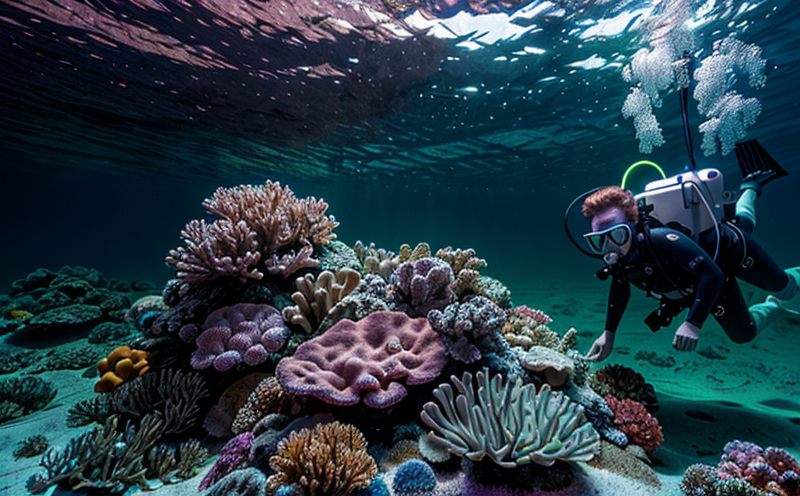IEC 62471 Photobiological Safety Testing of Underwater Lighting Products
The International Electrotechnical Commission (IEC) Standard IEC 62471 is a globally recognized technical specification that ensures the photobiological safety of lighting products. This standard is particularly crucial for marine and underwater environments, where light sources are exposed to unique environmental conditions. The primary focus of this service is on testing and certification of photobiological safety for underwater lighting products, ensuring they meet stringent international standards.
Underwater lighting devices can vary widely in design, application, and intended use. These devices often include LED lights, navigation lights, illuminators, and other fixtures designed to function effectively in aquatic environments. The IEC 62471 standard addresses the risk of photobiological hazards posed by these products, which could potentially harm operators or nearby marine life.
The testing process for compliance with IEC 62471 involves several critical steps. Initially, specimens are prepared according to specified guidelines provided in the standard. This may include cleaning and preparing samples for exposure under specific light conditions. The test setup replicates real-world scenarios where the lighting product is expected to operate, ensuring accurate assessment of its photobiological safety.
During testing, the apparatus used includes specialized photometers capable of measuring various parameters such as luminance, radiance, and irradiance. These measurements are crucial for evaluating whether the light source complies with the exposure limits defined in IEC 62471. The acceptance criteria strictly adhere to international standards, ensuring that only products meeting these stringent requirements pass testing.
The standard distinguishes between different categories of lighting devices based on their intended use and potential risks. For instance, category I devices are those with a low risk of photobiological exposure, while categories II and III represent higher levels of risk. The testing protocols vary accordingly to account for these differences in risk level.
Compliance with IEC 62471 is not just about meeting regulatory requirements; it also enhances product safety and reliability. By ensuring that lighting products do not pose a photobiological hazard, manufacturers can protect their reputation and ensure the trust of end-users. Additionally, adherence to this standard helps businesses comply with global regulations, reducing potential legal risks.
The testing process involves several key steps:
- Preparation of specimens according to IEC 62471 guidelines
- Exposure under specified light conditions
- Measurement and analysis using specialized photometers
- Evaluation against acceptance criteria defined in the standard
The benefits of achieving compliance with IEC 62471 extend beyond regulatory requirements. Compliance enhances product safety, reduces risk to operators and marine life, and ensures long-term reliability. It also provides a competitive edge by demonstrating commitment to quality and safety standards.
Benefits
The benefits of undergoing IEC 62471 photobiological safety testing for underwater lighting products are multifaceted. Primarily, it ensures that the product is safe for use in marine environments without posing any risk to human operators or aquatic life.
From a regulatory standpoint, compliance with this standard is mandatory in many jurisdictions where underwater lighting is used. This not only simplifies the process of exporting products but also reduces potential legal risks associated with non-compliance.
In terms of operational safety, IEC 62471 testing guarantees that light sources are free from photobiological hazards, thereby protecting workers and ensuring a safe working environment. Additionally, this certification can enhance brand reputation by demonstrating a commitment to high-quality standards.
The standard also facilitates easier access to international markets, as it aligns with globally recognized safety benchmarks. This is particularly advantageous for businesses operating in the marine sector or exporting products internationally.
For R&D engineers and procurement teams, IEC 62471 provides a clear framework for product development and sourcing decisions. It ensures that all lighting components meet stringent photobiological safety criteria, reducing the need for costly rework or recalls later in the production cycle.
Customer Impact and Satisfaction
The impact of IEC 62471 compliance on customers is profound. By ensuring that underwater lighting products are safe to use, this standard significantly enhances customer satisfaction and trust. Customers can be confident that the products they purchase not only meet regulatory requirements but also adhere to the highest safety standards.
For businesses operating in the marine sector or those exporting products internationally, compliance with IEC 62471 is a crucial factor in maintaining a positive reputation. It demonstrates a commitment to quality and safety, which can lead to increased customer loyalty and repeat business.
The standard also provides peace of mind for procurement teams by ensuring that only high-quality products are selected for use. This reduces the risk of purchasing substandard or potentially hazardous lighting equipment, thereby protecting both the company's reputation and its employees' well-being.
Use Cases and Application Examples
- Navigational aids in shipping and marine navigation systems
- Oceanographic research vessels equipped with underwater illuminators
- Diving equipment with built-in lighting for enhanced visibility
- Marine construction projects requiring underwater illumination
- Military applications involving underwater surveillance and communication devices
- Underwater aquaculture systems for monitoring and maintenance
- Submersible camera and sensor platforms used in deep-sea exploration
In each of these use cases, compliance with IEC 62471 ensures that the lighting products are safe to operate without posing any risks to human operators or marine life. This is particularly important for applications where prolonged exposure to light sources may occur.





